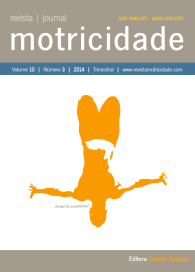Body composition analysis of athletes from the elite of Brazilian soccer players
DOI:
https://doi.org/10.6063/motricidade.3567Abstract
This study analyzed the body composition and bone mineral density of elite Brazilian soccer players and compared its differences according to the player position. Eighty-two soccer players competing at Brazilian first division were split according to their field positions: Goalkeepers (GK, n= 10), Back-fielders (BF, n= 10), Lateral-midfielders (LM, n= 15), Central-midfielders (CM, n= 25), Forwards (FW, n= 22), and a Control Group (CG, n= 72) of university students. To estimate fat free mass (FFM), fat mass (FM), percentage of body fat (%FM), fat free mass of legs (FFM-Legs) and bone mineral density (BMD), a DEXA was selected. The positions LM (10.5 ± 5.2), CM (9.7 ± 4.0) and FW (9.9 ± 4.4) had lower values of FM and %FM than the GK (17.3 ± 6.0) and the control group (15.0 ± 5.3). Compared to the other positions, FFM was higher in the GK (68.2 ± 10.9) and BF (64.6 ± 6.8) (p< 0.05). All the soccer players were different from the CG (p< 0.05). Soccer players have an FFM, FFM-Legs and BMD significantly higher and FM and %FM lower than the control group.
Downloads
Published
Issue
Section
License
The authors of submitted manuscripts must transfer the full copyright to Journal Motricidade / Desafio Singular Editions. Granting copyright permission allows the publication and dissemination of the article in printed or electronic formats and copyrights start at the moment the manuscript is accepted for publication. It also allows Journal Motricidade to use and commercialize the article in terms of licensing, lending or selling its content to indexation/abstracts databases and other entities.
According to the terms of the Creative Commons licence, authors may reproduce a reasonable number of copies for personal or professional purpose but without any economic gains. SHERPA/RoMEO allows authors to post a final digital copy (post-printing version) of the article in their websites or on their institutions' scientific repository.


